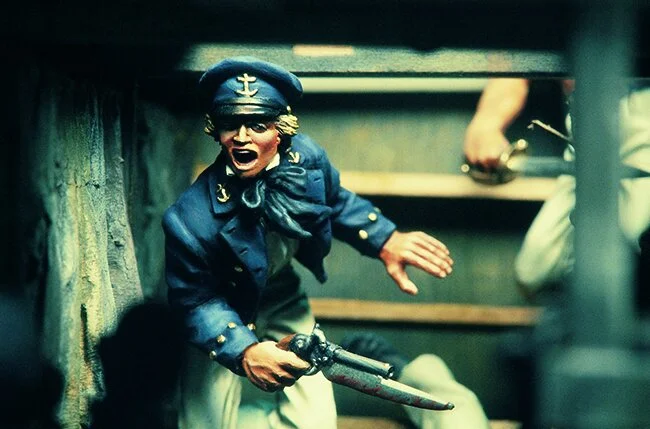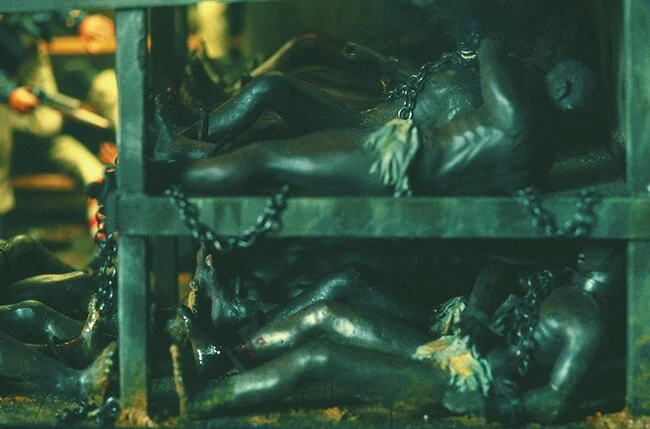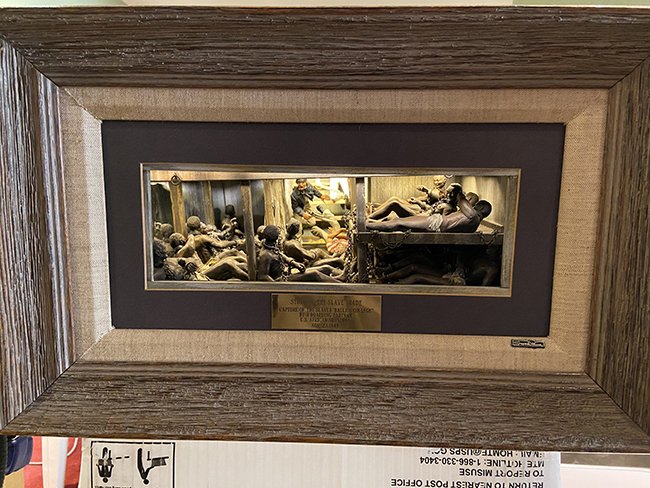This box is now in the collection of Darryl Audette
From Sheperd Paine: The Life and Work of a Master Military Modeler and Historian by Jim DeRogatis (Schiffer Books, 2008)
J.D. The next box is “Stopping the Slave Trade,” and I have to say, some of the faces of those slaves look familiar…
S.P. Yes, a lot of the faces of the slaves are the faces of the Zulus in the Rorke’s Drift scene, because I had cast a bunch of those heads.
J.D. The slaves in your box have literally been taken out of Africa!
S.P. The thing that intrigued me about “Stopping the Slave Trade” was that I was getting interested in the possibilities of lighting, and I liked the idea of having a dark foreground, with the only bright light falling in the center of focus at the back of the scene. The viewer’s eye is drawn to the very back of the box, where the midshipman is coming down the gangway, past the sprawled body of a slaver on the steps. He’s carrying a cutlass-pistol, one of those dual-purpose Victorian concoctions that only a midshipman would be dumb enough to buy.
J.D. What is the story behind this box?
S.P. It’s the capture of a slaver by a boarding party of the U.S. Navy in the 1840s. While the United States permitted slavery up until the Civil War, it stopped allowing slaves to be imported from Africa in 1819. The forerunner of the sleek America’s Cup boats were the Baltimore Clippers, most of which were built as smugglers and slave-runners. Slavers didn’t want to get involved in a gun battle with a valuable cargo of slaves onboard, so they relied on speed to outrun the patrols. Of course, as soon as they captured a fast slaver, the navy would immediately press it into service, giving them a fast ship to catch a fast ship.
J.D. The pictures don’t really do justice to all of the detail in this box. When I saw it later on in Ralph Koebbeman’s collection, I thought, “Wow, there are a lot of slave figures!”
S.P. It was important to make it look crowded, so this box also has a mirror on one side, which doubles the number of figures. It uses motion, too, rocking from side to side. There was something in the way the mechanism worked that caused the ship to actually creak as it rolled; I never figured out whether it was the rope or the pivot, but something was creaking, so I had unintentional sound effects, as well. It was a nice bonus!
Again, there are no spotlights in this one. There’s the light coming down from the hatch, and the ambient light from the room coming in from the front. I didn’t want a lot of illumination on the slaves.
J.D. Nevertheless, you really get a sense of how horrible the conditions were.
S.P. That was the purpose of the box. One’s eye is drawn to the figure in the back, but it eventually returns to the slaves in the foreground, and the appalling conditions they’re living in. I would hope people were affected by that, but I must admit I smiled at the reaction of a couple of guys I saw looking into it at a show. One was commenting what a terrible thing this was, and the other answered, “This is nothing—you ought to see third class!”
The full title of the piece, “Stopping the Slave Trade: Capture of the Slaver Balliol College,” comes from the fact that I’ve really enjoyed George McDonald Fraser’s Flashman books, so I paid him the quiet tribute of naming the ship after the one he described so vividly in Flash for Freedom.
JIM’S NOTES ON RESTORING THE BOX IN 2023
Above: The interior of the box before work began. Three of Shep’s five incandescent bulbs were burned out, and the motor for the motion turned, but the deck no longer moved, the pulleys seized up and the strings shot. Below: Work underway removing the incandescent fixtures (which had oxidized badly) and the pulley mechanism.
The inner-scene tray outside of the box; damn, it’s heavy! (The mirror is substantial, and there are A LOT of 100mm white metal figures in there.) Below: Shep’s cartoon on the right inside of the box.
The new LED strip lights installed, the same fixtures I used in restoring the Victory and the Monitor. They can be turned on and off and dimmed with an outside controller. I added some yellow “daylight” theatrical gel over the light where it shines down on the hatch and staircase. At first, I wondered why Shep had that old brown masking tape on the roof of the scene (see the previous pictures). It turns out he had cut narrow slats in the roof where the incandescents shined through the masking tape, adding the perfect muted tint to the bright light. I added some more of the same stuff over the grates, and got a final effect just like he’d intended.









